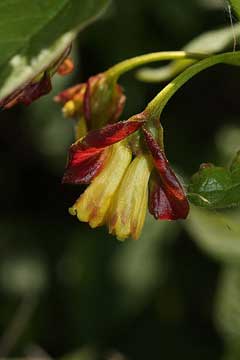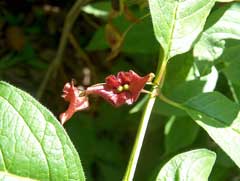 |
|
http://commons.wikimedia.org/wiki/User:Wsiegmund |
 |
| http://commons.wikimedia.org/wiki/User:Annelis |
Translate this page:
Summary
Physical Characteristics

 Lonicera involucrata is a deciduous Shrub growing to 1.2 m (4ft) at a medium rate.
Lonicera involucrata is a deciduous Shrub growing to 1.2 m (4ft) at a medium rate.
See above for USDA hardiness. It is hardy to UK zone 4 and is not frost tender. It is in flower in May, and the seeds ripen from July to September. The species is hermaphrodite (has both male and female organs) and is pollinated by Insects.
Suitable for: light (sandy), medium (loamy) and heavy (clay) soils. Suitable pH: mildly acid, neutral and basic (mildly alkaline) soils. It cannot grow in the shade. It prefers moist soil. The plant can tolerates strong winds but not maritime exposure.
UK Hardiness Map
US Hardiness Map
Synonyms
Xylosteum involucratum.
Plant Habitats
Woodland Garden Sunny Edge;
Edible Uses
Edible Parts: Fruit
Edible Uses:
Fruit - raw or dried[2, 46, 65, 155]. A pleasant taste[161]. Not tasty enough to be widely sought[212]. The only form we have tried has an incredibly bitter taste[K]. The fruit is about 8mm in diameter[200].
References More on Edible Uses
Medicinal Uses
Plants For A Future can not take any responsibility for any adverse effects from the use of plants. Always seek advice from a professional before using a plant medicinally.
Antidandruff Antipruritic Disinfectant Emetic Galactogogue Laxative Ophthalmic Pectoral
Poultice
Twinberry was employed medicinally by a number of native North American Indian tribes who used it to treat a range of complaints[257]. It is little, if at all, used in modern herbalism. The bark is disinfectant, galactogogue, ophthalmic and pectoral[257]. A decoction is used in the treatment of coughs and as an eyewash[257]. A decoction of the bark has been applied to a woman's breasts to encourage milk flow[257]. The bark has also been used as a dressing on burns[257]. The leaves are antipruritic and ophthalmic[257]. A poultice of the chewed leaves is applied to venereal sores, itchy skin and boils[218, 257]. A decoction of the leaves is used as an eye wash[257]. The fruits are antidandruff, emetic, laxative and pectoral[218, 257]. An infusion is used to treat chest and stomach complaints and to cleanse the body[257]. The mashed fruit has been rubbed into the scalp as a treatment for dandruff.
References More on Medicinal Uses
The Bookshop: Edible Plant Books
Our Latest books on Perennial Plants For Food Forests and Permaculture Gardens in paperback or digital formats.

Edible Tropical Plants
Food Forest Plants for Hotter Conditions: 250+ Plants For Tropical Food Forests & Permaculture Gardens.
More

Edible Temperate Plants
Plants for Your Food Forest: 500 Plants for Temperate Food Forests & Permaculture Gardens.
More

More Books
PFAF have eight books available in paperback and digital formats. Browse the shop for more information.
Shop Now
Other Uses
Disinfectant Dye Hair
A purple dye is obtained from the fruit[99, 257]. It is grey when tin is used as a mordant[168]. The berries are rubbed onto the scalp as a hair tonic. It is said to prevent greyness[99]. (don't mix the berries with tin though!![K])
Special Uses
References More on Other Uses
Cultivation details
An easily grown and very tolerant plant, succeeding in any fertile soil, and preferring a good moist soil in a sunny position[11, 200]. It produces less fruit when grown in the shade[200]. Plants have proved to be quite wind resistant when growing on an exposed site in Cornwall[K]. Plants are hardy to about -25°c[184]. Closely allied to L. ledebourii[11]. There are some named forms, developed for the ornamental garden[182]. 'Humilis' is a smaller form and 'Serotina' is later flowering[182].
References Carbon Farming Information and Carbon Sequestration Information
Temperature Converter
Type a value in the Celsius field to convert the value to Fahrenheit:
Fahrenheit:
The PFAF Bookshop
Plants For A Future have a number of books available in paperback and digital form. Book titles include Edible Plants, Edible Perennials, Edible Trees,Edible Shrubs, Woodland Gardening, and Temperate Food Forest Plants. Our new book is Food Forest Plants For Hotter Conditions (Tropical and Sub-Tropical).
Shop Now
Plant Propagation
Seed - best sown as soon as it is ripe in a cold frame. Stored seed requires 2 months cold stratification[113] and should be sown as soon as possible in a cold frame. When they are large enough to handle, prick the seedlings out into individual pots and grow them on in the greenhouse for at least their first winter. Plant them out into their permanent positions in late spring or early summer, after the last expected frosts. Cuttings of half-ripe wood, 7 - 10cm with or without a heel, July/August in a frame. Good percentage[78]. Cuttings of mature wood of the current season's growth, 15 - 20cm with or without a heel, November in a cold frame. Good percentage[78]. Layering in autumn[200].
Other Names
If available other names are mentioned here
Native Range
NORTHERN AMERICA: United States (Alaska (south), Michigan (northwest), Wisconsin (Gallatin Co.), Colorado (west), Idaho (south), Montana, Oregon, Washington, Wyoming, New Mexico, Arizona, California, Nevada (n.e. (Elko Co.)), Utah), Canada (Québec, Ontario, Saskatchewan, Alberta, Manitoba, British Columbia), Mexico (Chihuahua (north))
Weed Potential
Right plant wrong place. We are currently updating this section.
Please note that a plant may be invasive in one area but may not in your area so it's worth checking.
Conservation Status
IUCN Red List of Threatened Plants Status :

Growth: S = slow M = medium F = fast. Soil: L = light (sandy) M = medium H = heavy (clay). pH: A = acid N = neutral B = basic (alkaline). Shade: F = full shade S = semi-shade N = no shade. Moisture: D = dry M = Moist We = wet Wa = water.
Now available:
Food Forest Plants for Mediterranean Conditions
350+ Perennial Plants For Mediterranean and Drier Food Forests and Permaculture Gardens.
[Paperback and eBook]
This is the third in Plants For A Future's series of plant guides for food forests tailored to
specific climate zones. Following volumes on temperate and tropical ecosystems, this book focuses
on species suited to Mediterranean conditions—regions with hot, dry summers and cool, wet winters,
often facing the added challenge of climate change.
Read More
Expert comment
Author
(Richardson.)Spreng.
Botanical References
1143200
Links / References
For a list of references used on this page please go here
Readers comment
© 2010, Plants For A Future. Plants For A Future is a charitable company limited by guarantee, registered in England and Wales. Charity No. 1057719, Company No. 3204567.